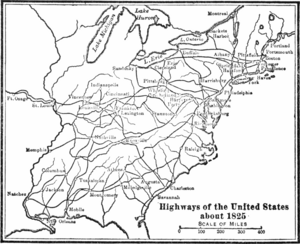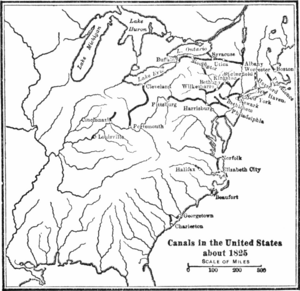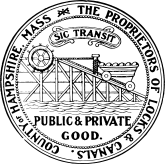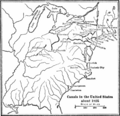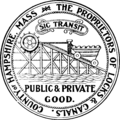History of turnpikes and canals in the United States facts for kids
The history of roads and canals in the United States is about how America built important travel routes. After the United States became independent, it started growing bigger, especially towards the west. Back then, people traveled by boat on rivers or walked and used pack animals on land. Leaders saw how ancient Roman roads helped connect their empire. So, they decided to build roads and canals to link different parts of the new nation. These new routes made it easier to move goods and people across the country.
Contents
Why New Roads and Canals Were Needed
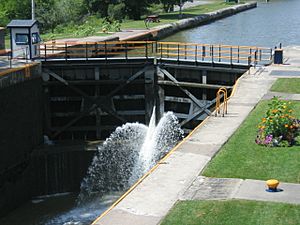
After winning the American Revolutionary War, the United States was a huge country. It stretched from New Hampshire to Georgia along the coast and reached inland to the Mississippi River. While shipping goods along the coast was easy, moving things inland was hard. There were rivers, but they weren't always connected.
Leaders like George Washington understood the problem. They started talking about improving rivers for travel. These early discussions eventually led to the creation of the U.S. Constitution. This showed how important trade and transportation were for uniting the states.
Early Toll Roads
The first major roads built were called toll roads. People had to pay a fee, or "toll," to use them. These roads were often built by private companies. For example, the Lancaster Turnpike in Pennsylvania was built in 1795.
In 1808, a government official named Albert Gallatin suggested that the national government should help pay for roads and canals. However, some politicians disagreed. They felt it was the states' job, not the federal government's.
The War of 1812 showed how badly the U.S. needed better roads. It was hard to move soldiers and supplies. After the war, construction began on the National Road in 1815. This important road started in Cumberland, Maryland, and eventually reached Vandalia, Illinois. It became a main route for settlers moving west over the Appalachian Mountains.
Building Canals
Just like toll roads, early canals were built by private companies. The first successful canal was the South Hadley Canal in Massachusetts, finished in 1795. Other early canals included the Dismal Swamp Canal in Virginia and the Middlesex Canal in Massachusetts.
After the War of 1812, New York decided to build the famous Erie Canal in 1817. This was a huge project, and it was paid for by the state government, not private companies. When it opened in 1825, the Erie Canal connected the Hudson River to Lake Erie. It used 83 special "locks" to raise and lower boats over a distance of 363 miles (584 km).
The Erie Canal was a massive success! It made shipping goods much cheaper and faster. Towns along the canal, like Syracuse, New York, Buffalo, New York, and Cleveland, grew into big cities. The success of the Erie Canal led to a "canal boom" across the country. Between 1816 and 1840, over 3,326 miles (5,353 km) of new canals were built. However, some states, like Pennsylvania and Ohio, spent so much money on canals that they almost went broke.
Government's Role in Improvements
The United States Army Corps of Engineers was created during the American Revolution. At first, they built forts and helped with coastal defenses. But many politicians wanted them to help with "civil works" too, like roads and canals.
Early presidents had different ideas about this. John Adams thought the national government should build roads and canals. But Thomas Jefferson believed the Constitution didn't give the federal government that power. He thought states should handle it.
Despite these disagreements, some federal money did go towards improvements. For example, in 1806, money from land sales in Ohio helped build the Cumberland Road.
After the War of 1812, it became clear that the country needed a national plan for transportation. President James Madison also called for a "comprehensive system of roads and canals." A bill was proposed to use money from the National Bank for these projects. However, Madison vetoed it, still believing it was unconstitutional.
Important Court Decisions
In 1824, the Supreme Court made a very important decision in a case called Gibbons v. Ogden. The Court ruled that the U.S. Congress had the power to control trade between states. This meant the federal government could make laws about transportation that crossed state lines, even if states had their own laws.
This ruling helped clear the way for more federal involvement. Soon after, Congress passed the General Survey Act. This law allowed the president to order surveys for important roads and canals. It also authorized improving rivers like the Ohio and Mississippi by removing obstacles. The United States Army Corps of Engineers was put in charge of these projects.
In 1826, Congress gave the Corps of Engineers even more work. They were told to survey rivers, clean them out, and make other improvements to harbors. This marked the beginning of the Corps' long history of working on civil projects across the country.
Even with these new laws, some political disagreements remained. But the Supreme Court's decision and the new acts of Congress set a new path. They showed that the federal government would play a much bigger role in building the roads and canals that helped America grow.
Images for kids
-
A lock on the Erie Canal


